Destructive behaviours in pets are a nightmare, but the reality is that a change in environment is likely going to cause a behaviour change. This means we can’t always expect a pet to behave as they normally do. A change in environment is unavoidable as a Pet Sitter – the owner leaving, a location change, other pets being present, or a change in routine are all going to impact how the pet behaves. The good news is there are plenty of ways to prevent and manage destructive behaviours, for cats and dogs.
 Why do pets show destructive behaviours?
Why do pets show destructive behaviours?
Destructive behaviour in pets always has a root cause, and understanding it will help prevent and manage it. A pet will often need to be taught how to utilise the replacement outlet you provide, showing them how to use it and continually re-directing them to it will dictate its success.
Managing destructive behaviours in cats
Cats’ two main destructive behaviours are scratching and chewing both with various root causes. They can be trickier to deter or train than dogs, as cats can be known for their stubborn and self-serving nature. Like any animal, it’s best to raise them with these boundaries and habits but it’s never too late to stop destructive behaviour.
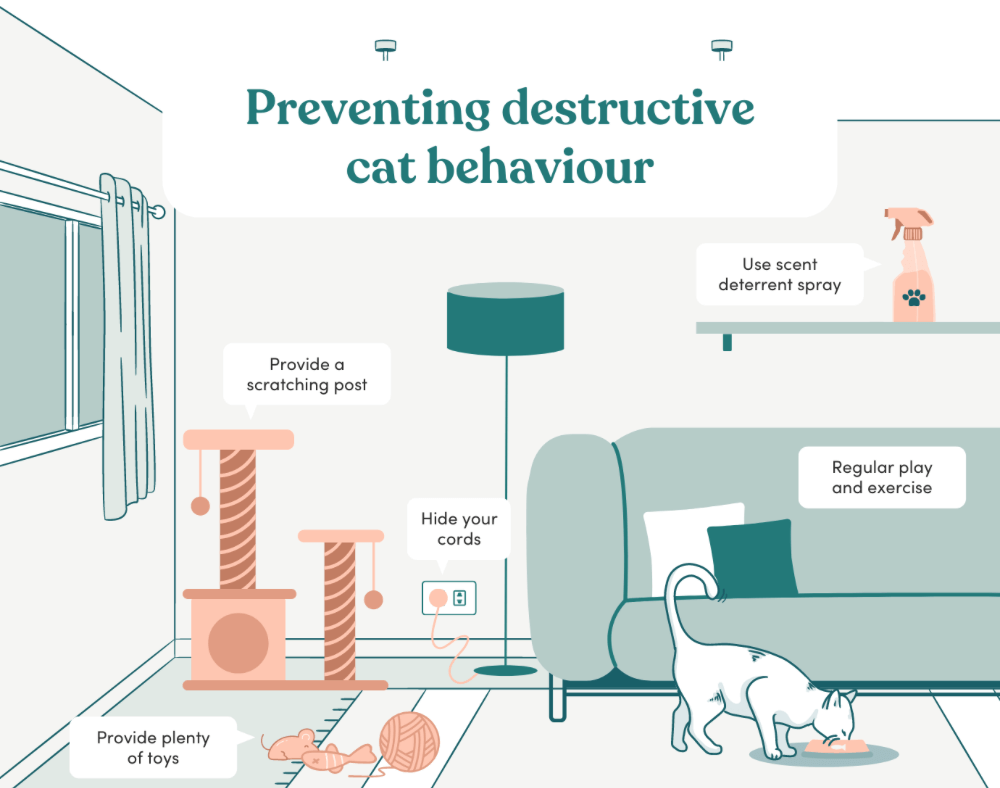 Why do cats scratch?
Why do cats scratch?
Cats often scratch at furniture (specifically couches) and it occurs when they don’t have a reasonable alternative such as a scratching post. Scratching has a much higher chance of occurring when the cat moves environments because it’s a marking behaviour. Hosting cats creates increased risks because they’re much less habituated to the outside environment than dogs, so it’ll likely be more stressful and disorientating for them.
To ‘stop’ scratching doesn’t mean to stop the cat from scratching altogether, it simply means stopping them from scratching anything they like and re-directing the behaviour to an appropriate outlet like a scratching post…instead of your couch! Re-directing the behaviour requires more than sticking a scratching post in the corner of the room. You must understand their preferences and teach them to use the replacement. To start, interrupt their scratching when it’s on the furniture and move them to the alternative. Follow up by rewarding them when they use the alternative. Keep this consistent, and in time they’ll learn to only use the alternative and the furniture will be safe. To prevent damage during the process you can place scratch guards or use a deterrent spray (such as citronella) on the areas to deter the cat from scratching there.
Scratching can sometimes be a display of emotion, especially excitement, or to remove dead parts off their nails. These will be much shorter bursts of scratching and the excitement shouldn’t be deterred so ensure you’re extremely positive about it and continue to re-direct them.
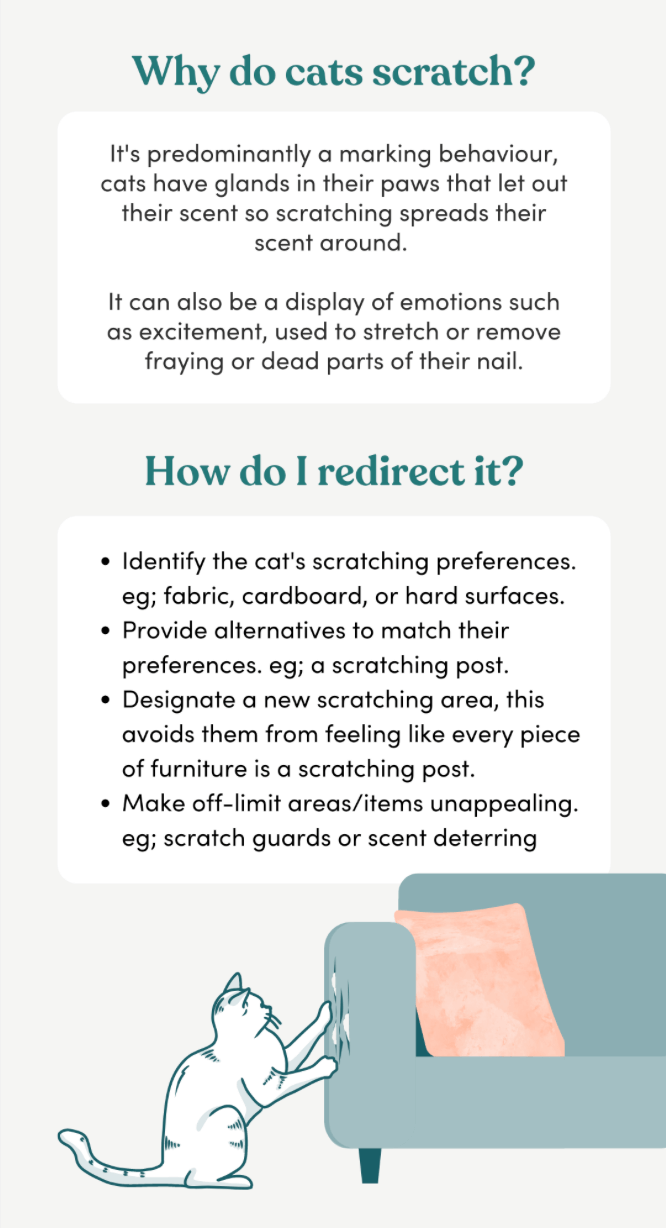 Unwanted chewing behaviour in cats
Unwanted chewing behaviour in cats
Chewing is another destructive behaviour in cats. Like all animals, it’s very prevalent during the teething stages. They also chew to use their back teeth at all ages or to entertain themselves, which is why you should always provide safe opportunities for chewing. In addition to providing safe options, you should protect electrical cords, remove toxic plants, and keep valuables out of reach. Alternatives for cats to chew include soft toys, chewy treats, dental chews and cat-specific chew toys. To replace the behaviour, it’s the same as scratching, interrupting the inappropriate behaviour, providing the alternative and rewarding the use of the alternative.
Excessive chewing in cats can be an indicator of poor dental health or gum disease. Other symptoms such as bad breath, bleeding gums, decreased appetite, poor grooming and not chewing meals, in addition to excessive chewing, should be checked by a vet.
Play is an important component in preventing destructive behaviour in cats. Because they’re ‘hunting’ animals, interactive play is great at preventing boredom. Flirt poles, moving toys or hanging toys are great to keep them engaged and allow an outlet for energy and hunting desires.
Managing destructive behaviour in dogs
Dogs’ destructive behaviours are more complex than cats, and due to size, can often be much more impactful. The top 6 destructive behaviours are: digging, barking, marking, jumping, chewing and escaping. Often destructive behaviour indicates that their needs are not being met and they’re trying to self-serve because their environment isn’t sufficient. Stopping these behaviours completely isn’t always the goal, though. Sometimes re-directing them is all that’s needed.
It’s important to remember that these persistent behaviours can be a dog’s way of trying to raise a red flag that something’s wrong, or at times just seeking information in an uncertain or new environment. Another reason dogs might do any of these behaviours is referred to as displacement behaviour, where a dog is overwhelmed with emotion and chooses that in an attempt to self-soothe in the way they grab a toy when people enter the home.
Managing digging behaviours in dogs
Digging is an intrinsic behaviour for plenty of breeds – burrowing and hunting breeds especially. It also serves as entertainment and resource-seeking. Dogs can sometimes even ‘dig’ when there is nothing to dig (like on a bed or the carpet) and even think they can bury a bone in the couch. This is to make their bed more comfortable, scent mark or attempt to bury food, normal behaviours for all kinds of dogs.
Digging is in a way a tool for dogs, who might dig to escape, seek resources and self-soothe. Re-directing the behaviour starts with understanding why they’re digging. Majority of the time it will be for entertainment and to fulfil those intrinsic behaviours. The most common solution is teaching them how to use the appropriate alternative, it’s a simple process. Start by interrupting when they dig in an inappropriate area, re-direct them to an appropriate area to dig and reward them when they use the replacement. Repeat this process until their first choice is the appropriate option.
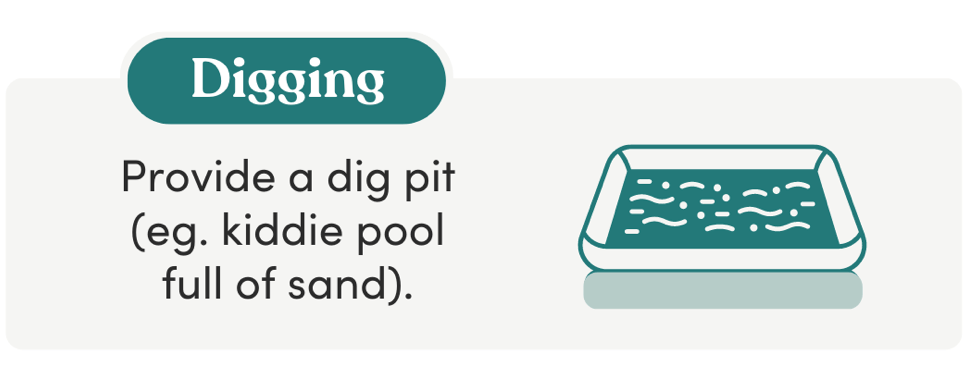 Alternative options include a kiddie pool full of sand or dirt, a snuffle mat, a sandpit, a designated digging spot in the garden or a DIY digging pit. Depending on the dog’s likes you can fill it with soft scraps, dirt, sand, balls, towels or whatever takes their fancy.
Alternative options include a kiddie pool full of sand or dirt, a snuffle mat, a sandpit, a designated digging spot in the garden or a DIY digging pit. Depending on the dog’s likes you can fill it with soft scraps, dirt, sand, balls, towels or whatever takes their fancy.
Unwanted or excessive barking in dogs
A very common behaviour that’s thought to be destructive in pets is barking. Barking is a very common self-soothing exercise for dogs which only re-inforces them to bark more since it makes them feel better. Barking is also a form of communication so they use it to express themselves or seek information. Unfortunately, dogs do not get tired of barking so waiting it out rarely ever works.
Barking is often caused by stress and or boredom. The best way to avoid consistent barking is to keep the pet occupied, stimulated, well rested and fulfilled. Ensuring their basic needs, food, water, exercise and mental stimulation is a great start. Always having plenty of opportunities for play, rest and company is the next level to keeping them satisfied.
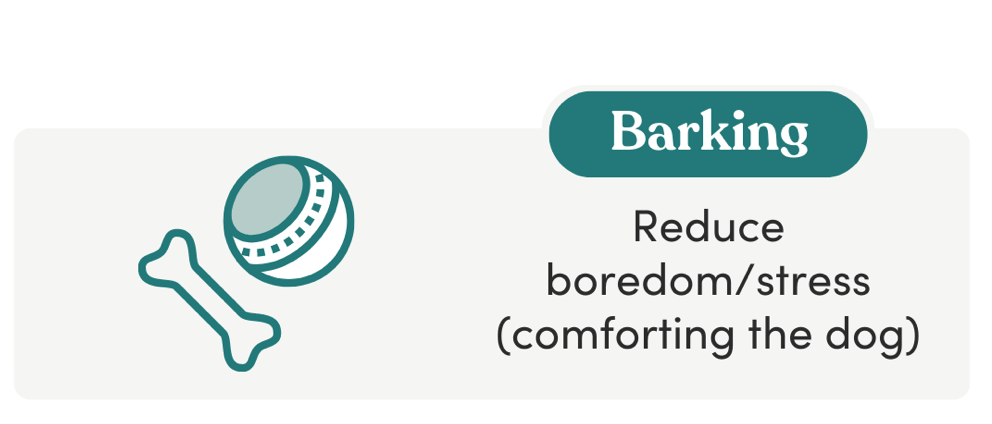 If barking is caused by stress, the first step is to comfort them and help them settle. Whether you should reach for a toy, a treat or a cuddle is dependent on the dog and their preference. Dogs that are prone to stress or response barking benefit greatly from having music or noise on in the background to help fade the noises that are causing the barking. If a dog is barking at you consistently, they’re most likely information seeking, trying to make sense of what’s happening. This is common when a dog’s owner leaves for the first time or with strangers. Comforting them and providing calming stimulation activities should help them settle.
If barking is caused by stress, the first step is to comfort them and help them settle. Whether you should reach for a toy, a treat or a cuddle is dependent on the dog and their preference. Dogs that are prone to stress or response barking benefit greatly from having music or noise on in the background to help fade the noises that are causing the barking. If a dog is barking at you consistently, they’re most likely information seeking, trying to make sense of what’s happening. This is common when a dog’s owner leaves for the first time or with strangers. Comforting them and providing calming stimulation activities should help them settle.
When your dog is marking their territory
Marking is primarily common in male dogs, often exacerbated when there are existing urine smells around or in un-desexed dogs. Getting rid of urine odour is the key to avoiding future markings from other dogs, or repeats. Strong odour removal products and vinegar are the most effective. Believe it or not, household cleaning products won’t do a good enough job. A dog’s sense of smell is much stronger than ours so they’ll be able to pick up any hint of scent.
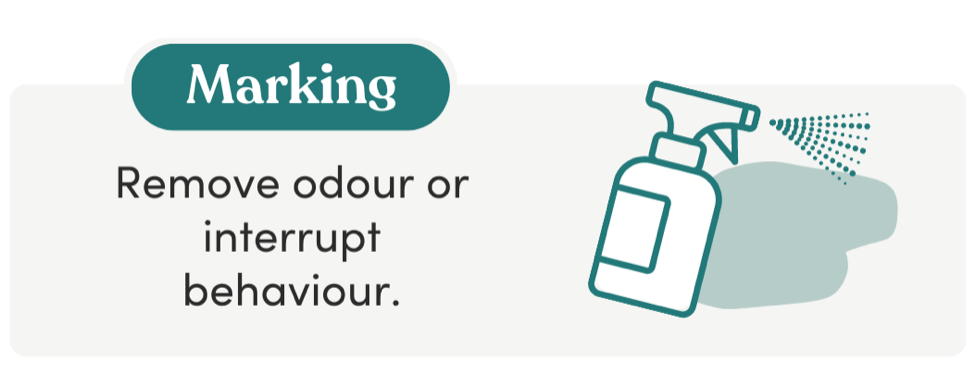 The most common solution is teaching them it’s not okay to toilet inside – but don’t worry, it’s a simple process. Start by interrupting when you catch them they’re urinating (or about to urinate) inside, and re-direct them to an outside area to do or finish their business. Make sure you reward them when they do. Repeat this process until their first choice is outside.
The most common solution is teaching them it’s not okay to toilet inside – but don’t worry, it’s a simple process. Start by interrupting when you catch them they’re urinating (or about to urinate) inside, and re-direct them to an outside area to do or finish their business. Make sure you reward them when they do. Repeat this process until their first choice is outside.
If the pet doesn’t correct their behaviour, you can utilise tools like belly bands or dog nappies with the owner’s permission.
Unwanted jumping behaviour in dogs
Jumping can quickly become dangerous – knocking over children, furniture, or other pets – and is usually trained out of puppies thankfully. Unfortunately though, when a dog becomes overstimulated it can become jumpy and without regulating their emotions can get nippy. Jumping can also be a seeking behaviour, jumping for a toy or treat which isn’t a reflection of good manners.
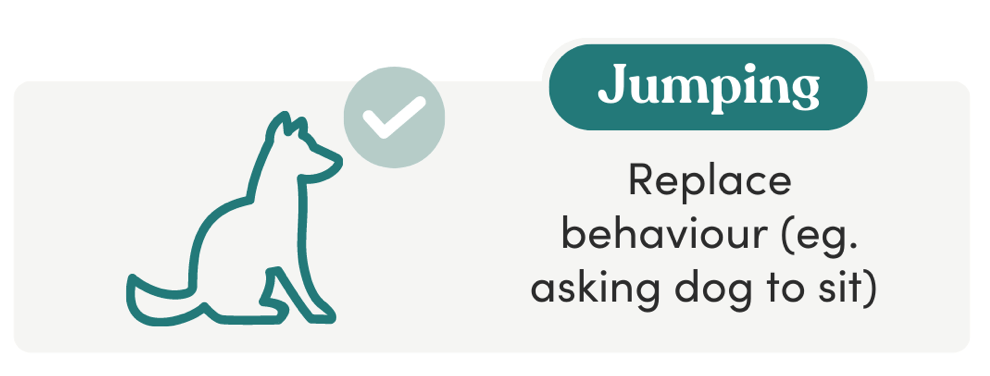 Jumping can be difficult to combat when caused by overstimulation. To start, the aim is to replace the destructive behaviours. Try to snap the pet out of that mindset by asking them to do something simple they’re familiar with, like sit. Ignoring the behaviour can also be useful. If they’re jumping, refrain from screaming, jumping back or reacting. Reacting to the behaviour can worsen the situation because if their intention is to seek attention, this teaches them that it works.
Jumping can be difficult to combat when caused by overstimulation. To start, the aim is to replace the destructive behaviours. Try to snap the pet out of that mindset by asking them to do something simple they’re familiar with, like sit. Ignoring the behaviour can also be useful. If they’re jumping, refrain from screaming, jumping back or reacting. Reacting to the behaviour can worsen the situation because if their intention is to seek attention, this teaches them that it works.
If jumping is situational – like walking through the door when coming home – you need to implement a routine where the dog is calm before you greet them. Do this by asking them to sit when you walk through the door, rewarding the sit and then greeting them. Or waiting for them to stop jumping and then greeting them. There are multiple ways but which is most effective depends on the dog and the scenario.
Problematic chewing in dogs
Chewing is a very important behaviour for dogs. Like babies, it soothes them through painful teething phases and is crucial to their mental and physical health. Chewing is an intrinsic behaviour for dogs – great to help mentally stimulate them. Chewing releases endorphins for dogs and helps avoid boredom. This can become problematic, however, when they chew the wrong things such as furniture, toxic plants, clothes or valuables. Providing appropriate chewing outlets stops them from searching to fulfil their need on their own. Constant chewing on appropriate items helps maintain teeth and gum health for dogs too.
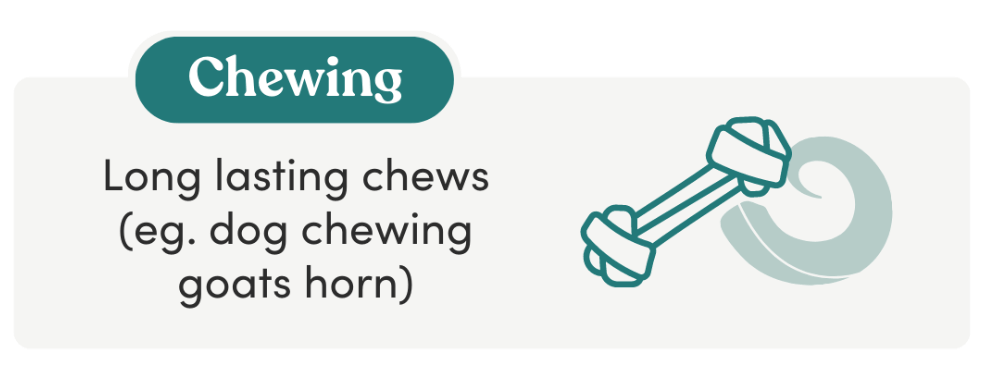 Teething phases in dogs are present until 7-8 months old, so any puppy under the age of 1 has a higher probability of destructive chewing behaviours. Constant chewing and teething behaviour is often present until 18 months old when the dogs begin to enter adolescence. Nipping, biting and chewing can be signs of teething pain, so providing lots of chewing options and soothing chewing options (like frozen chews) can ease their pain.
Teething phases in dogs are present until 7-8 months old, so any puppy under the age of 1 has a higher probability of destructive chewing behaviours. Constant chewing and teething behaviour is often present until 18 months old when the dogs begin to enter adolescence. Nipping, biting and chewing can be signs of teething pain, so providing lots of chewing options and soothing chewing options (like frozen chews) can ease their pain.
Opportunities to chew should be available for dogs at all stages of development, even older dogs need it. There are plenty of options, some need supervision and some don’t. Goat horns, pig ears, raw bones, dental chews, chew toys, frozen meat, frozen vegetables, long-lasting chews, chicken wings, chicken necks etc. Supervising dogs when they have chews like a goat’s horn or a chicken wing is crucial to ensure they don’t swallow too big of a chunk that can damage their intestines or swallow it whole and choke.
Managing pets who are known for escaping
Escaping pets cause extremely dangerous situations. They run the risk of being hit by a car, being stolen, getting trapped, or getting lost too far from home. It’s common for pets to try to find their way home when they escape, but it can be extremely disorientating if in a new environment like a sitter’s home. If the dog has separation anxiety or an extreme bond to their owner, they might try to escape any new environment.
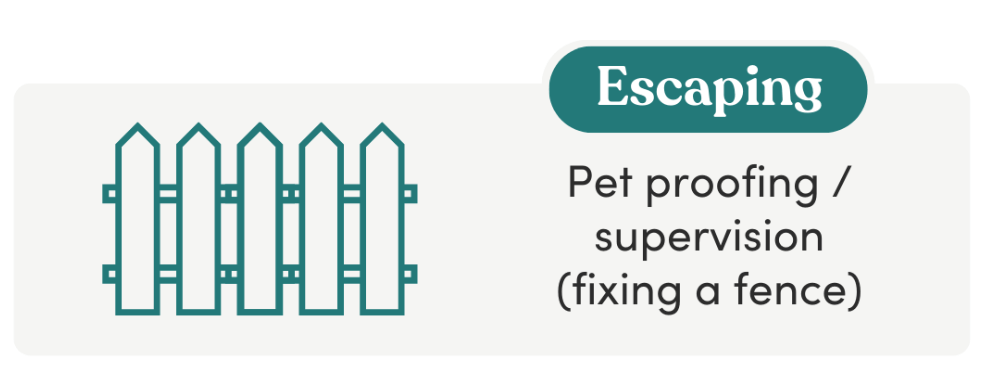 Pet proofing the home is the best way to prevent escapees, ensuring you can supply secure fencing and keep doors and windows locked etc. Always use caution when entering or leaving the home – often pets slip through the door unsuspectingly! If a pet is prone to escaping, ensure they have a name tag with a number and or address. Having a handful of temporary ones to place on pets in your care with your details is always helpful. There are also more extreme options like trackers or air tags to be able to find them in the unfortunate event they do escape.
Pet proofing the home is the best way to prevent escapees, ensuring you can supply secure fencing and keep doors and windows locked etc. Always use caution when entering or leaving the home – often pets slip through the door unsuspectingly! If a pet is prone to escaping, ensure they have a name tag with a number and or address. Having a handful of temporary ones to place on pets in your care with your details is always helpful. There are also more extreme options like trackers or air tags to be able to find them in the unfortunate event they do escape.
